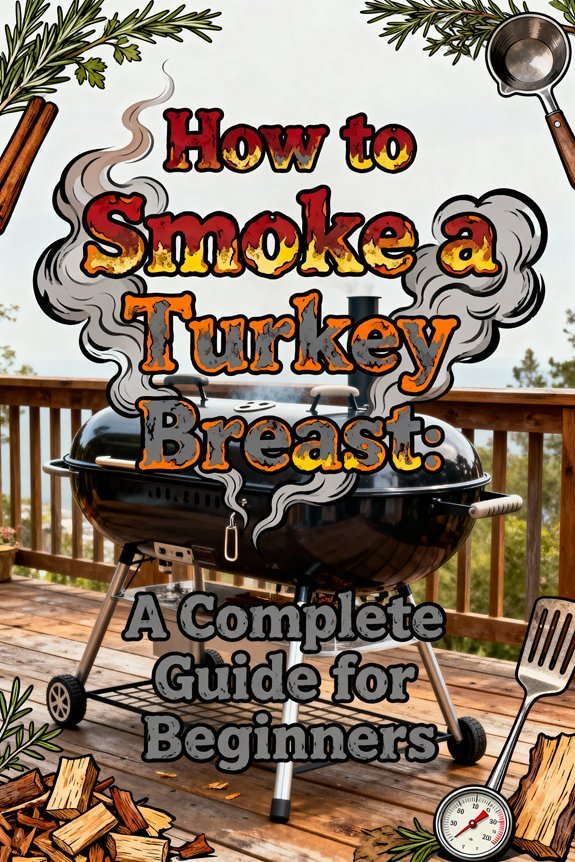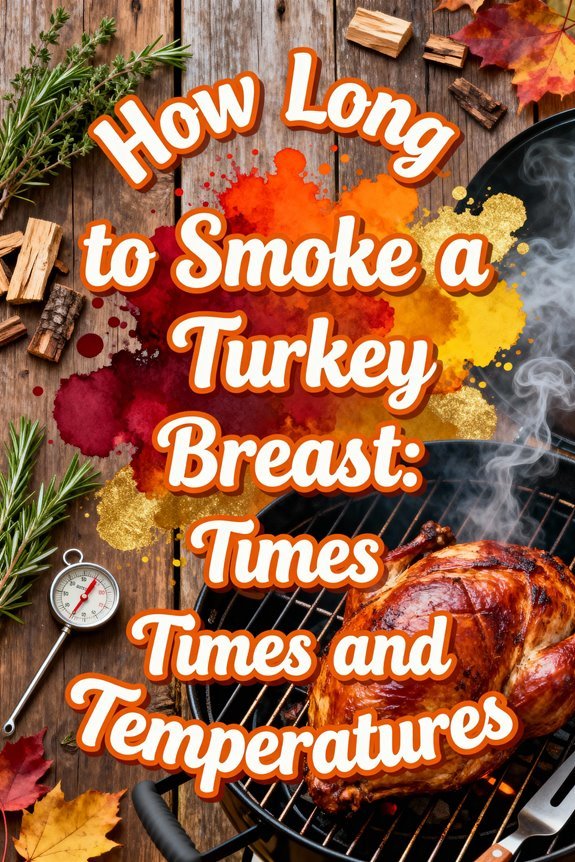To smoke a turkey breast, you’ll need a reliable smoker, digital thermometer, and quality hardwood. Start by brining your 2-4 pound breast for 8-18 hours, then pat dry and apply a dry rub. Preheat your smoker to 275°F and smoke for approximately 15 minutes per pound until internal temperature reaches 157°F. Let rest for 20-30 minutes before slicing. For ideal results, precise temperature control and proper technique make all the difference.
Essential Equipment and Supplies Needed
Three key pieces of equipment form the foundation for successfully smoking a turkey breast: a reliable smoker with temperature control capabilities, a digital meat thermometer for precise monitoring, and appropriate smoking wood.
Among the essential tools, you’ll need a proper smoker grate for even heat distribution and aluminum foil for resting the meat. If you’re using a pellet smoker or Traeger, make certain you’ve got enough wood pellets for 3-4 hours of continuous smoking. For traditional smokers, stock up on medium smoking woods like pecan, apple, or cherry. Maintaining steady temperature control between 225°F and 250°F is crucial for achieving optimal results.
Your equipment essentials should include heat-resistant gloves, basting tools, and food-safe brining containers. Don’t forget paper towels for drying the meat and small bowls for preparing your seasonings and rubs. A large container for your apple cider brine solution will ensure proper meat submersion during the 8-12 hour brining process. An accurate instant-read thermometer is essential for verifying the meat reaches safe temperature of 165°F in both the thickest parts.
Selecting the Perfect Turkey Breast
Success in smoking a turkey breast begins with selecting the right cut of meat. When considering size considerations, choose a 2-4 pound boneless breast for smaller gatherings or a 5-7 pound bone-in option for larger groups. Fresh vs. frozen is vital – opt for fresh turkey breasts with a natural pink hue and no discoloration for best results. Low-salt brining will help ensure optimal moisture retention and flavor distribution throughout the meat.
Bone-in benefits include better moisture retention and enhanced flavor, though boneless cuts offer easier uniform slices. Quality indicators to watch for include avoiding pre-enhanced or basted options, and verifying there’s no off-odor or discoloration. For successful cooking techniques, select skin-on breasts when possible, as they protect against drying during the smoking process. Just like with frozen chicken, ensure the turkey reaches an internal temperature of 165°F for safe consumption. Consider heritage or organic varieties for distinct flavor profiles, but make sure they’re properly sized for your smoker. For optimal smoke flavor, apple wood chips are an excellent choice when smoking turkey breast.
The Art of Brining Your Turkey
Brining your turkey breast is a critical step that transforms ordinary poultry into an exceptionally moist and flavorful masterpiece. The brine benefits include enhanced moisture retention, better seasoning distribution, and protection against drying during the smoking process.
Create your brine by combining ½-1 cup kosher salt and ½ cup sugar per gallon of water. You’ll achieve prime results by adding aromatics like peppercorns, garlic, citrus, and hardy herbs such as rosemary or thyme. Just as with smoking brisket, using low and slow temperatures will ensure the best results. Smoking at 275 degrees Fahrenheit will yield perfectly juicy results. Follow a precise brining timeline: submerge your turkey breast for 8-18 hours, using the one-hour-per-pound guideline for bone-in cuts. Don’t exceed 24 hours to avoid over-brining. A sealable plastic bag placed in a container works well for brining if space is limited. After brining, rinse thoroughly and pat dry. For the crispiest skin, air-dry in your refrigerator for 12-24 hours before smoking.
Preparing Your Smoker for Success
With your turkey breast properly brined, your focus now shifts to the smoker setup – a technical process that demands precision and attention to detail. Start by thoroughly cleaning your smoker’s grates and interior to guarantee ideal heat distribution and prevent off-flavors. Position your heat source for indirect cooking, and install a water pan to maintain essential humidity levels. Smoke for 30 minutes per pound when cooking at 225°F for consistently tender results. Disposable drip pans make cleanup easier while collecting flavorful juices.
For ideal temperature stability, preheat your smoker to 225-275°F before introducing the turkey breast. Install a calibrated probe thermometer in the thickest part of the meat and set alerts for 165°F internal temperature. Use quality hardwood like applewood or hickory, confirming it’s fully ignited before adding the meat. Monitor your fuel levels and adjust vents to maintain steady smoke production. In cold weather, consider using insulation to prevent temperature fluctuations. Adding aromatic herbs and lemon slices to the cavity will enhance the turkey’s natural flavors during smoking.
Seasoning and Rub Techniques
Seasoning a turkey breast for smoking requires precise measurements and careful technique to achieve the perfect balance of flavors. Start by creating your dry rub using core ingredients like brown sugar, smoked paprika, kosher salt, and black pepper, then customize the flavor balance with herbs such as rosemary, thyme, and sage. Before applying the rub, pat your turkey breast completely dry with paper towels to guarantee ideal adhesion. Store any unused portion of your rub mixture in an airtight container for up to three months in a cool, dark place.
For maximum flavor penetration, carefully lift the skin and apply the seasoning directly to the meat beneath. You’ll want to coat both the surface and under-skin areas thoroughly. If you’ve brined your turkey breast, reduce or eliminate salt from your rub to prevent over-seasoning. For enhanced moisture retention and better spice adhesion, brush the meat with oil or melted butter before applying your rub. Plan to smoke your turkey breast for 20-30 minutes per pound at temperatures between 225°F and 250°F for optimal results. Consider adding apple cider to your drip pan during smoking to maintain moisture and enhance flavor.
[affiai keyword=”bbq dry rub seasoning for turkey” template=”carousel” count=”3″
Temperature Control and Monitoring
Temperature control stands as the cornerstone of smoking a perfect turkey breast, requiring precise monitoring throughout the cooking process. You’ll need to maintain your smoker between 225°F and 250°F for ideal smoke absorption and even cooking. Temperature stability is essential, as fluctuations can lead to uneven results and tougher meat. Spatchcocking the breast creates more even cooking and better temperature control. Fifteen minutes per pound is a reliable guideline when smoking at higher temperatures around 275°F.
For precise monitoring techniques, insert a dual-probe thermometer into the thickest part of the breast, avoiding contact with bone. Set one probe to track internal temperature and another for smoker ambient temperature. Pull your turkey when it reaches 157°F, as carryover cooking during the 15-20 minute rest period will raise the temperature to the USDA-recommended 165°F. Using wireless thermometers reduces the need to open the smoker, helping maintain consistent heat and smoke levels. Similar to smoking ribs, adding moisture enhancers during cooking can help maintain juiciness and prevent the meat from drying out.
[affiai keyword=”wireless dual probe meat thermometer smoker” template=”carousel” count=”3″
Time Management and Cooking Phases
Successful smoking of turkey breast demands careful time management across distinct cooking phases. You’ll need to smoke the breast skin-side down for the first 1.5 to 2 hours to render fat, then flip it breast-side up for final cooking. Plan for approximately 38 minutes per pound at 275°F, or 50 minutes per pound at 250°F.
Following the 15-25 minutes per pound rule used for whole turkeys at higher temperatures, adjust your timing accordingly for lower smoking temperatures. Similar to smoking chicken, using fruit wood pellets can enhance the mild poultry flavor profile. Monitor internal temperature every 30-60 minutes initially, increasing frequency as you approach 140-150°F. Remove the breast at 160°F and rest it for 15-30 minutes to reach the safe 165°F through carryover cooking. During smoking, maintain consistent temperature and use a water pan to prevent drying. A mayo-mustard binder helps seasonings adhere better to the meat during the extended cooking process. If certain areas brown too quickly, tent them with foil. Total cooking time typically ranges from 4-6 hours, depending on breast size and smoker temperature.
Testing for Doneness and Safety
Three critical methods guarantee your smoked turkey breast reaches safe doneness. First, use a calibrated meat thermometer to verify the internal temperature reaches 165°F in the thickest part of the breast, avoiding contact with bone. Second, observe key doneness indicators: the skin should be golden brown and crispy, while the meat should appear opaque white throughout, not pink or translucent. Third, follow essential safety tips by maintaining steady smoker temperatures between 175-200°F and avoiding prolonged exposure to the bacterial danger zone of 140-165°F. Indirect heat setup helps maintain consistent temperatures throughout the cooking process. For optimal results, plan on smoking approximately 25 minutes per pound to achieve the perfect level of doneness.
Let your turkey breast rest loosely wrapped in foil after smoking, allowing carryover cooking to complete. For accuracy, verify final temperature with an instant-read thermometer in multiple spots before slicing. Only cut portions you’ll serve immediately to maintain ideal moisture. When preparing larger portions, consider cutting into pieces for more even cooking and safer temperature control.
Resting and Carving Methods
After your smoked turkey breast reaches the target temperature, proper resting is essential for peak moisture retention and tenderness. Remove the breast at 160°F and wrap it tightly in heavy-duty aluminum foil. Let it rest for 20-30 minutes, during which the internal temperature will rise an additional 5 degrees, guaranteeing food safety. Using either hickory or cherry wood will enhance the smoky flavor profile of your turkey breast during the cooking process.
For peak resting techniques, place the wrapped breast on a tray and keep it in a warm area. Similar to uniform sizes needed for kabobs, slice your turkey into consistent portions for even presentation. If you’re planning an extended rest of up to 2-3 hours, insulate it in a cooler with towels. When ready to serve, employ precise slicing methods: use a sharp knife to cut against the grain into uniform portions. Just like reheating leftover chicken, maintaining proper moisture is crucial for the best texture and flavor. Remember to let the meat rest completely before carving to maximize juice retention and guarantee clean, even slices.
[affiai keyword=”meat carving knife and meat thermometer” template=”carousel” count=”3″
Storage and Reheating Tips
Proper storage of your smoked turkey breast begins with complete cooling at room temperature to prevent condensation and bacterial growth. Once cooled, wrap the meat tightly in aluminum foil or place it in an airtight container and refrigerate for up to 4 days. For long-term preservation, consider freeze drying the turkey for a shelf life of up to 10 years. For extended storage techniques, freeze the turkey within three days of smoking using freezer-safe bags, removing as much air as possible to prevent freezer burn. Vacuum sealing can help preserve the smoked turkey for up to 3 months in the freezer.
When it’s time to serve, effective reheating methods are essential. Thaw frozen turkey in your refrigerator for 36-48 hours, then reheat in a 300°F oven. Place the meat breast-side up in a shallow pan with 2 cups of water and cover loosely with foil. Heat until the internal temperature reaches 140-145°F for best results without drying out the meat. Adding turkey stock to the pan during reheating helps maintain moisture and enhance flavor.
[affiai keyword=”food storage containers for smoked meats” template=”carousel” count=”3″







